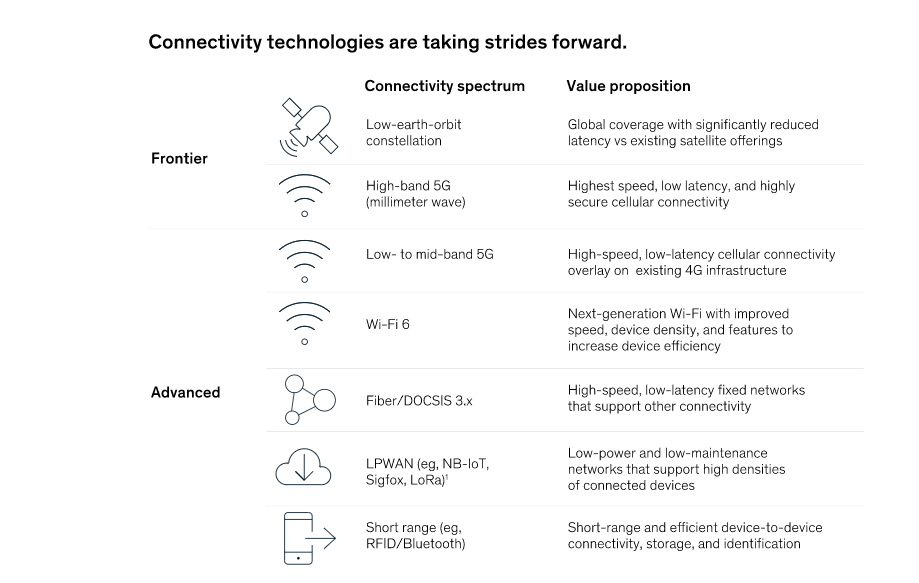
From fiber and satellites to Wi-Fi and short-range technologies McKinsey & Co.’s latest research ‘Connected World: An evolution in connectivity beyond the 5G evolution’ takes a more expansive look at the importance of connectivity in industries and businesses in the next decade.
The promise of 5G has captured the attention of business leaders, policy makers, and the media. With the first true high-band 5G networks already live, we set out to gain a realistic view of how and where connectivity could be deployed and what it can enable over the next 10 years. But 5G is not appearing in isolation. A new discussion paper published by McKinsey & Co. and called Connected World: An evolution in connectivity beyond the 5G evolution takes a more expansive look that ranges from fiber and satellites to Wi-Fi and short-range technologies.
To illustrate what is possible, this research looks at how connectivity could be deployed in mobility, healthcare, manufacturing, and retail. The use cases McKinsey identified in these four commercial domains alone could boost global GDP by $1.2 trillion to $2 trillion by 2030. This implies that the value at stake will ultimately run trillions of dollars higher across the entire global economy.
Advanced Connectivity Vs Frontier Connectivity
Most of this value can be captured with advanced connectivity, using technologies that have been available for some time now, and some natural evolutions. Existing connectivity technologies are expanding their reach as networks are built out and adoption grows. At the same time, the next generations of these technologies are appearing, with upgraded standards. Both of these trends are expanding and improving what we refer to as “advanced connectivity.” Advanced connectivity refers to low- to mid-frequency 5G networks that can offer significant improvements in speed and latency while supporting a greater density of connected devices.
In addition, a new type of more revolutionary (and more capital-intensive) “frontier connectivity” is emerging, although it is likely to have a more limited geographic footprint in the decade ahead, barring the mass-market deployment of satellite coverage. Frontier technologies like high-band 5G and low-earth orbit satellite constellations represent a more radical departure. Designed to be the most ultra-fast mobile option, high-band 5G (often in the form of standalone 5G) promises to put the speed, latency, reliability, and security of fiber in the air, expanding what mobile devices can do.
The advances described above are occurring alongside an expansion of hardware and software capabilities. Cloud computing will provide a processing backbone and storage capacity for use cases that require significant computational power. Edge computing will do the same while removing latency limitations. The new architecture of connectivity will also include private corporate networks. These connectivity and computing advances will enable cheaper and much more efficient “thin” devices connecting with the cloud and localized servers; they could become mainstream at the end of the decade for both consumers and businesses.

Connectivity at the Core of the Industries of Tomorrow
As the study pointed out, connectivity will enable businesses to do more in the next decade as well. Enhanced broadband will make streaming, downloads, and data exchange lightning fast. Because they require less power, LPWANs can extend the battery life of the devices and sensors they connect, making it viable for the Internet of Things to scale up like never before. Ultra-low latency and strong security will create the confidence to run “mission-critical” applications that demand absolute reliability and responsiveness—even in vital infrastructure systems and in matters of life and death. LEO satellites could provide true global coverage.
“Based on extensive research and expert interviews, we have identified hundreds of use cases in commercial domains that would run on both advanced and frontier networks. These are independent of the many consumer-driven entertainment and internet applications that are possible,” the McKinsey study stated. Using these as basis for their research and to convey the sheer diversity of use cases, as well as some of the opportunities and implementation challenges, the company has profiled four commercial domains with some of the largest potential to capture higher revenues or cost efficiencies.
Connectivity will be the foundation for increasingly intelligent mobility systems. While the automotive industry is at the heart, mobility is a broader concept that includes car-sharing services, public transit, infrastructure, hardware and software, and more—in short, all of the actors and enablers involved in moving people (and goods) from one point to another on the ground. Connectivity could open up new revenue streams through preventive maintenance, improved navigation and carpooling services, and personalized “infotainment” offerings. Vehicle-to-infrastructure and vehicle-to-vehicle communications can prevent collisions, enable various levels of vehicle autonomy, and improve traffic flow. We estimate the GDP impact in mobility to be $170 billion to $280 billion by 2030.
Connected devices and advanced networks could transform healthcare. Low-latency networks and high densities of connected devices and sensors make it possible to monitor patients at home in real time, which could be a major boon in the treatment of chronic diseases. Data can flow seamlessly throughout entire medical systems to smooth operations and coordinate care. AI-powered decision support tools can make faster and more accurate diagnoses, and many tasks can be automated so that caregivers can spend more time with patients. The ability to aggregate and analyze enormous data sets could yield new treatments. Together these use cases could free up additional investment capacity in healthcare and generate $250 billion to $420 billion in global GDP impact by 2030.
Manufacturing and other advanced industries can run highly precise operations using low-latency and private 5G networks. Smart factories powered by analytics, artificial intelligence, and advanced robotics can run at maximum efficiency, optimizing and adjusting processes in real time—not only on select assembly lines but across multiple plants. A growing number of factories will incorporate features such as automated guided vehicles and computer-vision-enhanced bin picking and quality control; these functions require the kind of speeds and ultra-low latency that high-band 5G networks provide. The GDP impact in manufacturing could reach $400 billion to $650 billion by the decade’s end.
Retailers can use sensors, trackers, and computer vision to manage inventory, improve warehouse operations, and coordinate along the supply chain. Connectivity can support frictionless in-store experiences—for example, eliminating checkout and adding augmented reality for better product information. Real-time personalized recommendations and promotions can increase sales. Some innovative retailers have already begun experimenting with and implementing some of these use cases, and advances in technology and affordability should lead to broader adoption by the decade’s end. These use cases in retail could boost GDP by $420 billion to $700 billion.
Beyond the implications for industry, connectivity also has ramifications for equity and society. Enabling more people to plug into global flows of information, communication, and services could add another $1.5 trillion to $2 trillion to GDP, over and beyond the economic value of the use cases identified in the four commercial domains highlighted in this research. Although gaps will remain, this trend could unlock greater human potential and prosperity in many developing nations.

Founder Dinis Guarda
IntelligentHQ Your New Business Network.
IntelligentHQ is a Business network and an expert source for finance, capital markets and intelligence for thousands of global business professionals, startups, and companies.
We exist at the point of intersection between technology, social media, finance and innovation.
IntelligentHQ leverages innovation and scale of social digital technology, analytics, news, and distribution to create an unparalleled, full digital medium and social business networks spectrum.
IntelligentHQ is working hard, to become a trusted, and indispensable source of business news and analytics, within financial services and its associated supply chains and ecosystems











